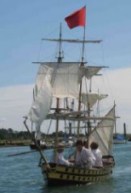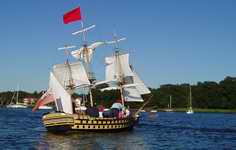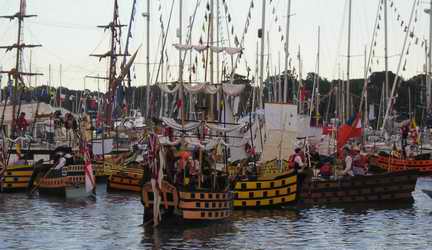| Click on a link below to go to that page. |
|
 
Why don't we build
a working replica of one of Nelsons line of battle ships for the Bursledon
regatta re-enactment?? We couldn't see
any reason at all, unless you count a Fastnet campaign, full time
jobs and only two spare weeks to do it in!
So we were allocated
HMS Belleisle , which as the second ship in Collingwood's column had
acquitted herself famously before being dismasted by the combined
fire of three enemy ships. She was built in France as the Formidable
, taken , and re-named for the British navy. Ben searched through
the Exeter university library and found a set of books describing
in minute detail the building , rigging and manning of a French 74
gun ship of this time, and we bought a 50 year old GP 14 on E-bay
, scaled down the drawings, ordered the wood for spars and so on our
return from the Fastnet we were all ready to go.
There followed
a mad two weeks with up to 20 friends at a time working , often late
into the night, to convert this ancient dinghy into a working model
of a 74.
The night before
the regatta we rigged her in a warehouse in Hamble and towed her down
to the Southern at first light. Having safely negotiated the streets
we sped through the lifting barrier only to snap both topgallant masts
on the unseen telephone wires in the car park. Undaunted ( after all
, this would have been commonplace on the real ship although for reasons
of weather and gunfire rather than telephone lines!) two more were
hastily made and a vast horde finalised the rigging , launched her
and we made our way steadily up the river under sail , having our
first lesson in sailing a full rigged ship , albeit under topsails
jibs and spanker. The battle was wet and fun , though as the only
truly sailing vessel in the fleets , we were determined not to emulate
our namesake and lose our rigs!
Over the next
2 days we refined the running rigging and increased our skills under
the tutelage of 80 year old Admiral Lancelot Bell-Davies , who had
been taught by his father ( also an Admiral ), who had learnt HIS
square rig sailing at Dartmouth from seamen alive at the time of Trafalgar.
We sailed her to windward, tacked, wore ship, hove to and even sailed
her backwards. We learnt how difficult it was to beat to windward
in confined spaces as once we got going at the magic 70 degrees to
the wind we could make good ground but each tack lost us all we had
gained. No wonder our forebears had such fear of a lee shore.
Finally, as dusk
fell we sailed once more to the pool at the Elephant boatyard, luffed,
furled all but the backed mizzen topsail which dug in our anchor,
cracked open the champagne and settled down to listen to the concert
on the foreshore.
Our 50 year old
hull was fairly rotten in places so she was de-commissioned , the
hull repaired , decking strengthened and the forefoot deepened , before
being laid up in the garden for a slow refinement of the rig. The
plan for 2006 is to have all 16 sails and their associated rigging
working and to take her on some extended voyaging in the Solent in
order to learn more about this ancient art. Come and join us !
|
 |
 |
|
|
 |
 |
 |
|
|
 |

Well , that might have been the plan ,but this was now a one man operation , and the sheer complexity of a full rigged ship meant many hours of enjoyable reading , planning , visits to museums and leisurely pottering - but inevitably , very slow progress.However in the Christmas holidays full sail was eventually hoisted ( in the garden!) , a few more lesons learnt and Belleisle was once more laid up in ordinary to see what 2007 might bring
I genuinly didnt know what to do with her! Was it going to be feasable to work her with her new complexity?Sailing a square rigged ship is of necessity a slow and patient process, and Ii began to doubt if anyone else would have the time , or indeed interest , to devote to this.
Our first outing was a disaster. Several critical ropes were led incorrectly , the wind was blowing up and down the river so we laboriously towed her upwind and ran backdown to the mooring with far too little time to get sorted. 2 weeks later we took a gentle Northerly from Bursledon, and with the flood slowing our progress, had oodles of time to sort everything out , and ended up sailing out of the river under full sail with cameras snapping at us like Russian canon at Balaclava. I learnt that if you have a commanding wind to leave the river , getting in is going to be nigh on impossible , and vica versa. These vessels were designed to sail the open seas - getting to windward in enclosed waters is not their forte
Gradually the problems began to resolve themselves.One afternoon the entire Foulkes clan turned out to help sail her , making me feel that there were other folk interested. Then Lynda and I sailed her on our own one gentle evening in a NW wind - and arrived back from where we started entirely on our own efforts. Next we solved the problem of getting out of the river to windward - waiting for the height of the Spring ebb, heaving- to mid channell, then backing and filling whilst the tide took us out of the river into sufficient room to sail. Another day Ben and I took a Northerly out of the river, sailed out to Calshot , and beat back in with the flood . The fact that we were seriously embayed at one stage and had to hastily resort to anchoring only reinforced the fact that we were learning how to work her as the real ships would have been worked 200 years before. Finally the problems of stability and scale wind seemed less worrisome due to the simple ( ! ) expedient of being able to reef the topsails and set the appropriate amount of sail - in exactly the same way as our ancestors.
Peoples reactions are mixed. Some regard the project with a mixture of cynicsm and pity . .I heard someone say "poor chap must have too much time on his hands " . I wish! Most people seem genuinly interested and I swear we have yet to pass any boat without the whole crew lining the rail with cameras. The nicest comment came from a boat full of fishermen - "Youve got the bestt yacht on the river mate!"
So what does the future hold for the project? As at every stage , "Its a mystery!" I have a list of improvements and now feel confidant enough to set out without a rescue craft or tug .Belleisle is once more laid up , this time sans masts , and we will just have to see what 2008 brings along.
So far we have updated the rig from 1780 to 1800 so that the mizen course is now a gaff rig rather than a sprit. This bigger sail gives us more weather helm and helps to stop the bow paying off through a tack. Was this why the change was made then? It also takes away the sprit which used to hit the aft crew in the head - strictly a problem of scale that our forebears did not have to worry about! .Lynda wondered out loud wether we could skip the next 250 years til they invented cam cleats - but was roundly ignored.
We also added 2 staysails. These are much easier to tack than the fore and main courses , and come into their own when short tacking in the river. The running rigging was further modified so as to be stronger , and each group of ropes led to adjacent cleats to make the whole thing (slightly) more manageable.
As you can see from the photos we have been more adventurous with trips out into the Solent to Calshot, Ashlet creek and Thorness bay on the island.
For more photos click here.
|
| |
|
| |
|
| |
|
|














